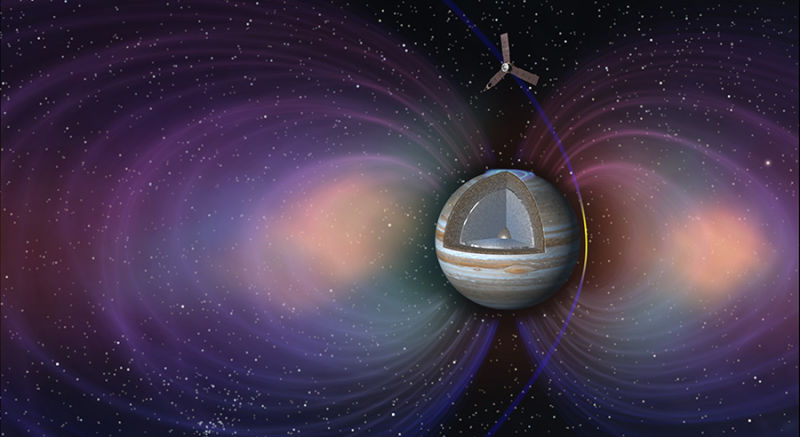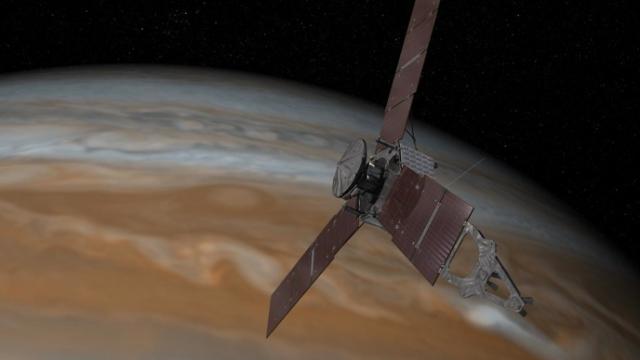NASA’s Juno spacecraft has been spinning through space on its way to Jupiter for five years and 716 million kilometres, and now it’s less than 10 hours away from entering the gas giant’s orbit — the equivalent of a single rotation of Jupiter. If all goes well, scientists will finally be able to learn what lies beneath Jupiter’s turbulent atmosphere, examine its impressive magnetosphere and possibly determine the composition of its core.
Image: NASA/JPL/Caltech
But first, it’s going to have to execute a tricky 35-minute engine burn under the harshest conditions that any NASA spacecraft has yet faced. And that has Juno mission scientists on edge today. They have modelled every scenario they can think of, and planned for every contingency. But as Juno project manager Scott Bolton said in this morning’s briefing at the Jet Propulsion Laboratory in Pasadena, “This is the highest risk phase.”
“We’ve done everything humanly possible to make this mission a success, but it’s still a cliffhanger,” said Jim Green, director of planetary science at NASA headquarters in Washington, DC.
Thus far, the mission has gone off without a hitch, but plenty could still go wrong. For instance, what if the main engine doesn’t fire on cue to start the burn, so far from the sun? “We’ve fired the main engine twice successfully and the third time should be a charm,” said Rick Nybakken, Juno project manager. “But this is the first time we’ve ever fired the main engine at Jupiter. It’s make or break for us.”
Then there’s the intense radiation from Jupiter’s enormous magnetosphere. According to Heidi Becker, lead investigator for Juno’s radiation monitoring, this translates into millions of high energy electrons moving near the speed of light. “They will go right though the spacecraft,” she said. “It’s the equivalent of 100 million X-rays in less than a year for a human being if we had no protection.”
Juno’s polar orbit will avoid the worst of the radiation belts at the planet’s equator, but other high-intensity regions are unavoidable. This exposure could easily fry Juno’s electronics, which is why they are housed in solid titanium radiation vaults with walls half an inch thick.

Artist’s concept of Juno sweeping through Jupiter’s powerful magnetic field. Image: NASA/JPL-Caltech
Juno will start to experience that radiation fairly early in the orbital insertion manoeuvre. Towards the middle of the burn is another dangerous phase, because the gas giant also has a ring of debris around it, similar to the Van Allen Belt that surrounds Earth. At this point Juno will be travelling at very high speeds and its engine doors will be open and vulnerable, according to Bolton. “If Juno gets hit even by a small piece of dust, it can do a great bit of damage,” he said. “We believe probability is incredibly low that Juno will hit dust or debris, but it’s not zero. Even a 10 micron particle could do some damage moving at the speed we’re moving.”
Finally, because Juno is now so far from Earth, there is a 48-minute delay before any signal from the spacecraft can reach Earth, and the burn only lasts 35 minutes. It’s going to be a nail-biting extra 13 minutes. And since the spacecraft’s antenna will not be facing Earth, the team will track its position via Doppler radio signals on a main carrier frequency, and tones on subcarrier frequencies, similar to our emergency broadcast system. Different frequency tones will be sent to mark the different milestones of the manoeuvre.
Here’s the mission timeline, for those following along:
7:30PM PT (12:30PM AEST): Juno will reach Jupiter’s north pole and turn away from the sun. The clock starts ticking — will it complete the orbital insertion before the solar-powered batteries run out?
8:18PM PT (1:18PM AEST): Juno will fire its main engine and commence the 35-minute burn.
8:53PM PT (1:53PM AEST): Burn complete.
9:30PM PT (2:30PM AEST): Juno will reorient itself to the sun and recharge its batteries. Then, and only then, Bolton will relax. “I won’t breathe easy until we’re back on sunpoint because we’re solar powered,” he said. “We’ve got to get the blood flowing through Juno’s veins again. That’s the key.”
If all goes well, Juno will complete it first orbit in 53 days, and JPL scientists should get the first data at the end of August.
We’ll be streaming the live feed from JPL later today. And here’s our Facebook Live interview from Friday with Juno project scientist John (“Jack”) Connerney:
